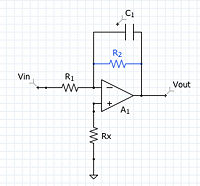Integrator Amplifier: Difference between revisions
No edit summary |
|||
| Line 3: | Line 3: | ||
===Integrator === |
===Integrator === |
||
[[Image:Integrator_ben.jpg|200px|thumb|right|Graph of a typical Integrator Amp circuit (drawing redrawn by Ben Henry)]] |
[[Image:Integrator_ben.jpg|200px|thumb|right|Graph of a typical Integrator Amp circuit (drawing redrawn by Ben Henry)]] |
||
The circuit at right integrates the input voltage <math>V_{in}</math> by using an |
The circuit at right integrates the input voltage <math>V_{in}</math> by using an amplifier. |
||
<math>V_{out} = \frac{-1}{R_{1}*C}\int V_{in} dt |
<math>V_{out} = \frac{-1}{R_{1}*C}\int V_{in} dt |
||
| Line 11: | Line 11: | ||
"<math>R_{2}</math> ; Provides negative feedback for low output impedance needs. But it also distorts the output."<sup>1</sup> |
"<math>R_{2}</math> ; Provides negative feedback for low output impedance needs. But it also distorts the output."<sup>1</sup> |
||
The use of an |
The use of an integrator circuit is the opposite of a differentiator circuit. In other words, If you have a triangle wave input and you differentiate it you will get a square wave output. If you run the square wave as the input to an integrator circuit you will end up with the triangle wave for the output<sup>2</sup>. |
||
The |
The resistor (<math>R_{2}</math>) is used to provide feedback<sup>3</sup> of the output DC voltage. Without this, circuit wouldn't perform as calculated because of the un-ideal conditions of real life. |
||
==Contributers== |
==Contributers== |
||
| Line 18: | Line 18: | ||
--[[User:Benjamin.henry|Benjamin.henry]] 23:15, 10 January 2010 (UTC) |
--[[User:Benjamin.henry|Benjamin.henry]] 23:15, 10 January 2010 (UTC) |
||
== |
==Reviewers== |
||
[[Greg Fong]] |
[[Greg Fong]] |
||
*http://en.wikipedia.org/wiki/This_article_does_not_cite_any_references_or_sources.#Footnote_system |
*http://en.wikipedia.org/wiki/This_article_does_not_cite_any_references_or_sources.#Footnote_system |
||
Revision as of 14:55, 13 January 2010
Amplifiers
Integrator
The circuit at right integrates the input voltage by using an amplifier.
" ; Provides negative feedback for low output impedance needs. But it also distorts the output."1
The use of an integrator circuit is the opposite of a differentiator circuit. In other words, If you have a triangle wave input and you differentiate it you will get a square wave output. If you run the square wave as the input to an integrator circuit you will end up with the triangle wave for the output2. The resistor () is used to provide feedback3 of the output DC voltage. Without this, circuit wouldn't perform as calculated because of the un-ideal conditions of real life.
Contributers
--Benjamin.henry 23:15, 10 January 2010 (UTC)
Reviewers
- http://en.wikipedia.org/wiki/This_article_does_not_cite_any_references_or_sources.#Footnote_system
- I don't think I would capitalize amplifier, differentiator , differentiate, integrator or resistor.
- I believe you mean triangle wave and square wave, in place of ^^^ and square sine wave.
- After you take these comments into consideration, email me again and I'll take a look at it once more.
Victor Shepherd
- I agree with Greg just like you did with square sine wave do the same with triangle wave instead of ^^^, makes it confusing and I don't believe that's a standard way of representing it.
- I will add one more thing. You don't need to have the types of waves within "".
Sources
1 Quick Study "Electronics 1, Part 2"
2 Practical Electronics for Inventors (p545, 2nd edition)



